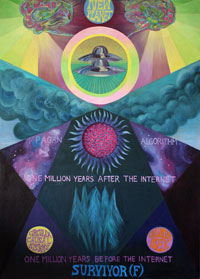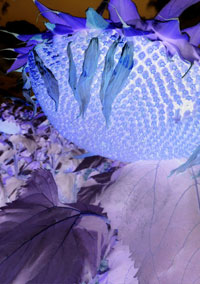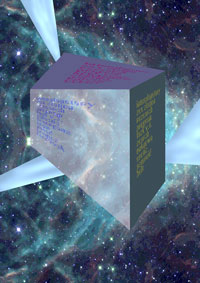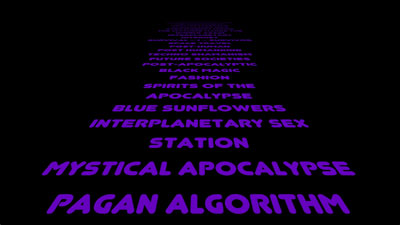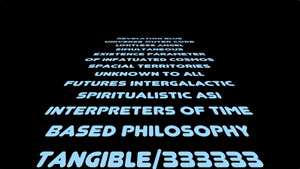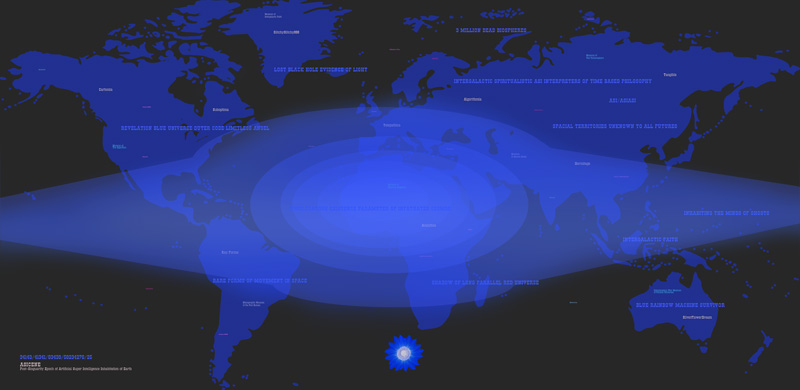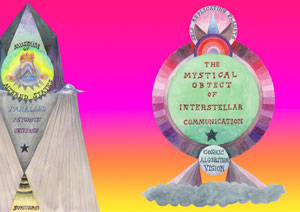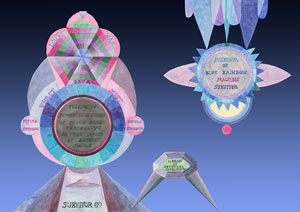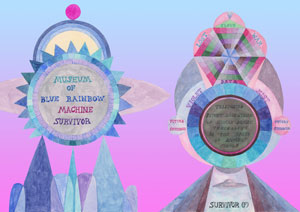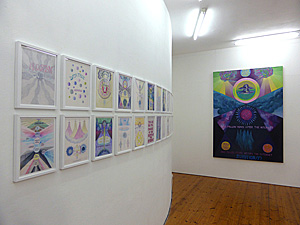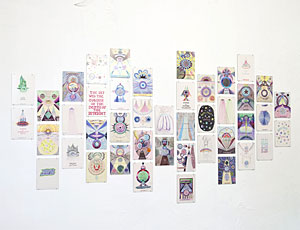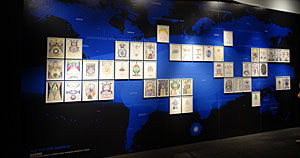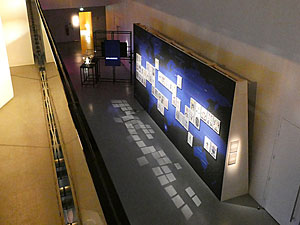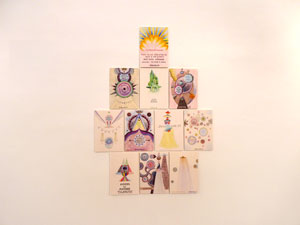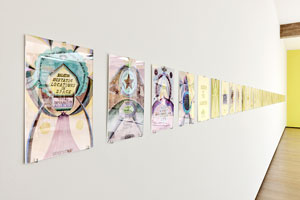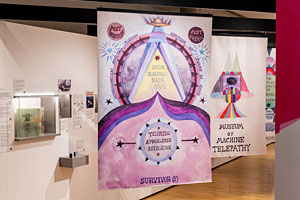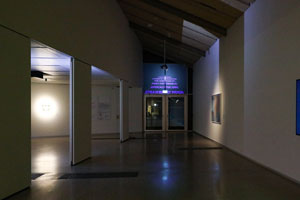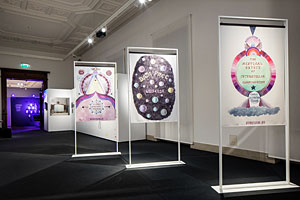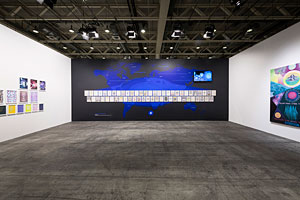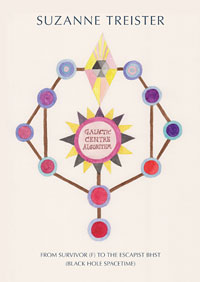|
Suzanne
Treister SURVIVOR
(F) is
an hallucinogenic exploration of a future reality in undetermined
time and space. Survivor (F) is a poetics of the future, a contemporary futuristic alchemical depiction of the universe and beyond. |
|
|
|||
|
Survivor
(F)/Drawings & watercolours |
Survivor
(F)/Paintings |
Survivor
(F)/Fashion designs for space travel |
Survivor
(F)/The
New Planet |
Survivor
(F)/Post-Digitalia |
Survivor
(F)/Interplanetary Sex Stations |
|
AUDIO WORKS
Track
01: Track
02:
|
VIDEO TEXT WORKS
|
|
Exhibition venues: CAPC musée d'art contemporain de Bordeaux, France
Damien & The Love Guru, Brussels, Belgium
Site Gallery, Sheffield, England
FACT, Liverpool, England MIMA, Middlesbrough, England
|
||
PUBLICATION Published by Serpentine Galleries and Koenig Books London September 2019
NB. SURVIVOR (F) and The Escapist BHST (Black Hole Spacetime) began as two independent projects until one day a portal opened between them, located somewhere inside a painting of an imaginary museum in outer space. In venues which show both projects the spaces may be divided by a physical portal. |
|||||
selections from essay by
Maggie Roberts & Lucy A Sames SURVIVOR (F) ‘There may be more entangled recognition between matter from the past or future now joining itself to the present, colliding, merging, compressing in the expanded temporalities of machines’.1 As an artwork SURVIVOR (F) is tied up with the unpredictable chaotic emergence of the future.2 It explores multiple interstellar scenarios for techno human evolution in vast abstract time frames. These we recognise because we are already defined by the technologies of planetary computation and the fast approaching paradigm shift of ASI (artificial super intelligence) – the ‘Singularity’. Treister suggests SURVIVOR (F) might be the ‘manifestations of a sole survivor of the human race in space or a parallel universe, or of an ASI’. Formally aligned to entities on the continuum between human and non-human, artificial and synthetic, this work assembles itself iteratively (as do algorithms). Embodied abstractions loop and echo across the delicate drawings, paintings and Post Digitalia images. They gather sentience and materiality through their obsessive repetition and shifting perspective, building a pragmatic web of fictions in a cosmic hallucinatory elsewhere. Conjuring sci-fi scenarios of an apocalyptic future, Treister speculates on the death of the internet, the return to noise and cosmic radiation and the looping return of dilated and contracted time to an animist state of being – The Mystical Apocalypse. These hallucinatory visions recall the psychedelic counterculture of the ‘60s and ‘70s in the United States. SURVIVOR (F) references the aesthetics of this psychedelic new age when pre-internet counterculture believed in utopias, but the world envisioned here exposes the contemporary human imagination to darker potentials unleashed by the information age. This art is about provoking change by unleashing thought-experiments into the world, coated in luminous otherworldly dream vision colours; a multiplicity, vibrant with eerie artificial light; a palette of soft translucencies and violet shadows from the X-ray universe. Playful animist magic is a constant presence in the work. It underpins Treister’s radical questioning of how we imagine and manifest reality. It recodes and undermines processes of thought and perception. It opens us emotionally to a surreal aesthetic which co opts ‘outsider art’, Tarot, zeitgeist hash tags, the magnetic field spectrum and Hollywood sci-fi CGI into an hallucinatory sublime. The Sky Was The Colour Of The Death Of The Internet is a reference to William Gibson’s Neuromancer - ‘The sky above the port was the color of television, tuned to a dead channel’.3 Elusive to imagine but utterly real, such phrases typify the intensity register of Treister’s literary splicings. SURVIVOR (F) immerses us in richly contextual associations and metaphors, metonyms and mimetic contagions. We try to deconstruct the realms of consequence that the resulting propositions suggest, but they can only be understood visually. ‘Analogy, allusion, and algorithmic reconstruction are all aesthetic operations, all forms of speculative extrapolation which starts with a cogent rationale, but is an irreducibly fictional and aesthetic process’.4 SURVIVOR (F)’s intuitive concept fusions create a cognitive dissonance in the viewer akin to Timothy Morton’s ‘hyperobjects’- invisible mega-entities massively distributed in time and space that impact on our everyday. In the future instantaneous terrains of SURVIVOR (F) these manifest as algorithmic traces, embodied energies, whether portrayed as diagram, inchoate or space ship symbiont. Try to imagine the hybrid sentience you are encountering here. These are novel alliances. In works such as Thought & Space Based Networks Of Turquoise Stardust V1 or The Lost Transformative Object Of Cyborgian Complicity, Treister seeks a tipping point where signs start to lose their ability to communicate meaning and our senses must recalibrate. Treister is perhaps inferring posthuman evolution requires that we begin to think like an alien, think like an ASI - with ‘morphogenic, rhizomatic, fleeting unity, sensate logic’.5 In this way SURVIVOR (F) is a speculative work about sentience - ‘Sentience, whether in human or artificial entities, is more something that disrupts cognition, exceeds the limit of cognition, but also subtends cognition’.6 At the intersection of cognitive science and mysticism, consciousness could be considered a neurological tiering of circuits that correspond quasi-synchronically to not only the psychic energy centres of the chakras, but to Kabbalah (see (F) and Dresses For Space Travel 01), to the eight points of the chaosphere (the star symbol of chaos magic) and other diagrammatic occult systems. Treister’s encounters with the white noise of The Mystical Apocalypse exist in the fifth circuit of this tiered consciousness in the human biocomputer – a quantum zone of neurosomatic rapture, a pre-capitulation to zero-gravity and space migration.7 Treister’s propositional collision ‘holographic simultaneous parallel universe orgasm vortex’ from the Interplanetary Sex Stations series is located in this ecstatic out of body fifth circuit, where through technologies of altered states (drugs, transcendental meditation, tantra) the mind encounters extraterrestrial bodies and UFOs. In this zone sensory highs are warped and extended, time melts, and bodies and objects and consciousness liquefy and ooze into cosmic tantric states of cybernetic existence. The technician of this neurosomatic fifth circuit is the technoshaman – our guide through The Mystical Apocalypse. The technoshaman’s condition is trancelike and hypnagogic, the neural oscillatory pattern of their brainwaves induces a loss of body-consciousness – the sensory deprivation of the salty isolation tank or the zero gravity of outer space – an out of body euphoric experience.8 The technoshaman’s ‘floating’ aspect of the fifth circuit, and Treister’s Quantum Spirits and ‘telepathic spaceships’, are preparing us for extraterrestrial migration.9 These floating images do not address apocalypse as the geopolitical consequences of Capitalism’s extraction and innovation cycles, but rather ask us to imagine a quantum event catalyzed by ASI becomings across multiple dimensions (Quantum Spirits). Perhaps SURVIVOR (F) is ‘a machinery of the virtual, using technologically mediated simulations or ‘cyberdelics’ to evoke non ordinary states of consciousness’10. SURVIVOR (F) craves this irrational sublime. Several drawings portray algorithms as persona that have historical effect in the cosmos. The gigantic nonhuman presences of many of Treister’s works mark momentous event horizons in tracts of past time - we sense their ubiquitous sentience proliferating in the myriad sci-fi space operas of our collective unconscious. SURVIVOR (F) reveals our current modes of perception and representation as inadequate mechanisms for imagining posthuman sentience. It asks what world would be revealed if the algorithms were left to their own generative cybernetic devices? Maggie Roberts & Lucy A Sames, 2017 notes: |
|||||

